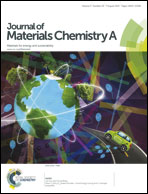Morphology-dependent performance of Zn2GeO4 as a high-performance anode material for rechargeable lithium ion batteries†
Abstract
In this study, the electrochemical performance of hollow Zn2GeO4 nanoparticles as an anode material for lithium-ion batteries (LIBs) has for the first time been investigated and compared to other morphology-type Zn2GeO4 materials with a solid nanorod structure. The results show that the lithium-storage performance is morphology-dependent and the presence of hollow voids is beneficial to enhance the charge–discharge capacity at different current densities. Specifically, the capacity of hollow Zn2GeO4 nanoparticles is approximately 200 mA h g−1 higher than that of Zn2GeO4 solid nanorods after 60 discharge–charge cycles at a current density of 200 mA h g−1 and such high performance (ca. 1200 mA h g−1) is in the front rank of current anode materials and three times as high as that of commercial graphite-based anodes (372 mA h g−1). Moreover, hollow Zn2GeO4 nanoparticles show better rate capacity and the specific capacity is approximately 300 mA h g−1 higher at a current density of 2000 mA h g−1 in comparison with Zn2GeO4 nanorods. The hollow voids not only lower the charge transfer resistance by facilitating lithium-ion diffusion, but also effectively buffer against local volume changes. Therefore, considering the easy and environmentally friendly synthesis and the high performance (high reversible capacity and good rate capacity), such hollow Zn2GeO4 nanoparticles are a very promising candidate as a high-performance anode material for LIBs.


 Please wait while we load your content...
Please wait while we load your content...